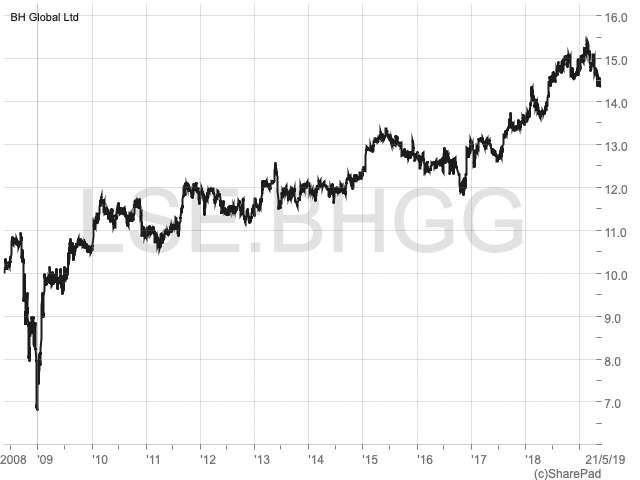How to diversify through alternative investment trusts

Nick Sudbury explains how investors can dampen the impact of market volatility through taking advantage of alternative assets via investment trusts.
It has been more than a decade since the financial crisis with the low interest rates and loose monetary policy driving up the value of traditional asset classes such as equities and bonds. The high prices in these areas are beginning to look increasingly vulnerable as the global economy starts to slowdown. This could mean that investors who are overly exposed could experience large capital losses right across the board.
| First seen in Master Investor Magazine
Never miss an issue of Master Investor Magazine – sign-up now for free! |
One of the most effective strategies to reduce this risk is to allocate part of your portfolio to alternative investments. These typically have a lower correlation to more mainstream assets and will dampen the impact of market volatility.
For most retail investors the easiest way to do this is to take advantage of the growing number of alternative investment trusts that are available in areas such as infrastructure, renewable energy, specialist property, and listed hedge funds. Alternative investment trusts account for the majority of new capital raised in recent years and now have a collective market capitalisation of £77bn, which represents around 47% of the total investment trust universe by value.
Last year was more challenging with the alternatives sector only attracting £5.1bn of new money, down from £9bn in 2017, although this still represented 60% of the total capital raised. Out of this figure the thirteen IPOs accounted for £1.27bn – the remainder being secondary issuance from existing funds − with just two of them meeting or exceeding their targets. They were Tritax Eurobox (LON:BOXE), which invests in continental European logistics assets; and Hipgnosis Songs (LON:SONG), which provides exposure to music royalties.
Most mainstream asset classes lost money in 2018, with the more economically sensitive alternatives like property and specialist debt also typically losing ground. The main bright spots were the renewable energy sector, which delivered some steady performance in line with its return targets, and infrastructure where the funds produced some decent numbers.
Infrastructure
Sentiment towards the infrastructure sector was undermined in the first half of last year by political concerns about the impact of a possible Labour government and increased counterparty risk following the collapse of the services provider Carillion. Things then improved with the takeover of John Laing Infrastructure at a 20% premium to NAV leading to a positive re-rating of the sector as a whole.
Infrastructure funds provide exposure to a whole range of different assets, including schools, hospitals and roads, as well as energy transmission systems and oil storage facilities, both in the UK and overseas. The portfolios are typically well diversified and actively managed with target returns varying between 7%-10% per annum and yields of 4%-7%.
The analysts at Canaccord Genuity and Numis both recommend HICL Infrastructure (LON:HICL). At the end of September the £2.7bn fund provided exposure to a diversified portfolio of 117 investments, of which 70% by value were the politically sensitive PFI/PPP projects with a further 22% allocated to demand-based assets.
In the six months to the end of September, HICL delivered an impressive total return of 7% including the dividends. It has an attractive prospective yield of just over 5% and offers excellent protection against inflation with each 1% increase resulting in a 0.8% uplift in portfolio revenues. The shares are trading on an 8% premium to NAV.
Both firms also recommend the £2bn International Public Partnerships (LON:INPP), which they say has an advantage over its peers due to its primary origination capability. The manager has a proven track record of sourcing a broad range of assets, often direct from public sector counterparties, as the first owner of equity.
INPP’s portfolio is the most diversified by asset type in the sector with the 130 assets providing exposure to educational buildings, healthcare facilities, energy transmission, gas distribution, waste water and transport. It also has the highest inflation correlation and offers a prospective yield of 4.5%. The shares are currently trading on a premium of 10%.
Renewable Energy
2018 was a decent year for the renewable energy sector with an improvement in power prices helping the funds to produce some strong returns. The majority of these vehicles aim to generate energy from wind farms or solar farms, or a combination of the two. They typically invest in assets that produce long-dated income of around 20 years through inflation-linked subsidies or by selling power at the prevailing market price. Target returns are in the range of 7%-9% per annum, including yields of 6%-7%.
| First seen in Master Investor Magazine
Never miss an issue of Master Investor Magazine – sign-up now for free! |
Numis recommend Bluefield Solar Income (LON:BSIF), which delivered the sector’s strongest share price total return of 11.4% in 2018. The manager exercises strict pricing discipline and this has enabled him to build up a high quality portfolio without having to raise substantial new amounts of capital. BSIF generates strong cash flows and at 6% it has one of the highest yields in the peer group.
When they first launched, most of these funds assumed a useful economic life of the underlying assets of around 25 years, but the latest technical advice suggests that they could be expected to last longer. Bluefield has not yet assumed any extension and has therefore not benefited from the uplift of its NAV.
The only fund to have assumed an asset life extension across the whole of its portfolio is Greencoat UK Wind (LON:UKW), which has moved from 25 years to 30, although the managers are keen to stress that they have taken a conservative approach to the net cash flow assumptions in the extra 5 years. Numis regard it as a high quality business and have included it in their model portfolio for the year, although they suggest waiting until the 15% premium falls back, possibly after the next capital raise. It is currently yielding 5%.
The analysts at Winterflood prefer John Laing Environmental Assets (LON:JLEN) because it provides exposure to a range of renewable energy technologies and environmental projects including wind, solar, anaerobic digestion, waste and wastewater. This means it has the lowest sensitivity to changes in the long-term forecast for power prices in the sector.
Since the fund was launched in March 2014 it has delivered an annualised NAV total return of 6.2% per annum and is currently yielding 6%. It has high cash dividend cover of 1.2x with the managers committed to raising the pay-out in line with inflation. The shares are trading on a premium of 11.7%.
Specialist property
Many UK commercial property funds were de-rated last year because of the weak outlook for capital growth and specific concerns about the retail sector. These fears are less of an issue for some of the more specialist mandates, especially those that offer reliable long-term inflation-linked revenue streams.
Numis like the Secure Income REIT (LON:SIR) that invests in a portfolio of long-lease assets in the Hotel, Healthcare and Leisure sectors. These include: 20 freehold private hospitals, four well-known visitor attractions and 131 Travelodge hotels. All of the leases benefit from either inflation or fixed uplifts with the fund yielding around 4%.
They also recommend the LXI REIT (LON:LXI), which has built up a diversified portfolio of secure, long-dated and inflation-linked leases across a range of subsectors. The fund managers have been successful at crystallising uplifts and quickly recycling the capital. It is one of the most attractive opportunities amongst the long-lease peer group, and although the shares are trading on a 19% premium they continue to offer an attractive 4.2% yield.
The team at Winterflood prefer the Tritax Big Box REIT (LON:BBOX), which invests in very large logistics facilities in the UK. They say that it has performed well since the launch in December 2013 and has generated an annualised NAV total return of 13% that is well ahead of its 9% per annum target. It offers a fully covered prospective yield of 5% and operates in an area that should benefit from high occupational demand for its assets.
Listed hedge funds
| First seen in Master Investor Magazine
Never miss an issue of Master Investor Magazine – sign-up now for free! |
There was a mixed performance from the listed hedge fund sector last year with the event-driven funds like Boussard & Gavaudan (LON:BGHL), Third Point Offshore (LON:TPOU) and Pershing Square (LON:PSH) all struggling, while the macro trading funds managed by Brevan Howard − BH Global (LON:BHGG) and BH Macro (LON:BHMG) − profited from the more volatile market conditions.
In the year to the end of December 2018 BH Macro generated an impressive NAV total return of 12.4% from the sterling-hedged share class. It was particularly successful at exploiting the volatility in May, with the sell-off in Italian bonds helping the NAV to rise by 8.2%, and although the rest of the year was a lot quieter the manager was still able to protect investors’ capital during the market weakness in the fourth quarter.
The analysts at Numis and Winterflood both have the fund as a core recommendation this year. They describe it as an interesting portfolio diversifier with the potential to deliver consistent NAV returns with low volatility and little correlation to the equity markets.
Uncorrelated doesn’t mean low risk
The principal attraction of alternatives is that they have a lower correlation with mainstream assets, which means that they could continue to deliver positive returns when other areas sell-off, but this doesn’t make them low risk. In fact over the last few years there have been a number of problems in this area with one fund after another running into difficulties.
A case in point is the Ground Rents Income Fund (LON:GRIO), which suffered a major sell-off in 2017 when its share price moved from a 6% premium to an 11% discount after the government announced a review of the ground rents sector following allegations of unfair practice.
Investors in CATCo Reinsurance Opportunities (LON:CAT) have fared even worse, with massive losses in the last 12 months. The fund’s Catastrophe Reinsurance Bonds have been hit by a series of natural disasters including Hurricane Michael and Typhoon Jebi and it is now running down its portfolio.
Those with money in the aircraft leasing funds such as Doric Nimrod Air One (LON:DNA), Doric Nimrod Air Two (LON:DNA2) and Doric Nimrod Air Three (LON:DNA3) suffered losses of up to 10% on 14 February when it was announced that Emirates Airline was going to reduce its A380 Airbus order book by 39 aircraft. All of these funds invest in A380s leased to Emirates with the news raising concerns about their residual value at the end of the lease.
There have also been problems experienced by some of the peer-to-peer lenders that have been de-rated because they have failed to meet their target returns, with those affected including P2P Global Investments (LON:P2P), Funding Circle (LON:FCIF) and Ranger Direct Lending (LON:RDL), and with the last two now being in realisation mode.
FUND OF THE MONTH
BH Global (LON:BHGG) had a steady 2018 with a NAV total return of 5.4% from the sterling share class. It has been recommended by the analysts at Canaccord Genuity, who say that last year’s positive performance when most asset classes lost value demonstrates the fund’s core purpose to be a low volatility, risk-controlled diversifier and a building block in portfolio construction.
| First seen in Master Investor Magazine
Never miss an issue of Master Investor Magazine – sign-up now for free! |
During 2018 the exposure to the flagship Brevan Howard Master Fund was increased from 21% to 46%. This aims to deliver consistent risk-adjusted returns in different market conditions via a range of trading strategies. It had a fantastic 12 months with a gross return of 16.6% as some of the more traditional strategies returned to profitability after many years of distortion caused by QE.
Most of the rest of the assets are allocated to individual traders in what is known as the Single Manager Portfolio. Last year the weighting in this area was cut from 63% to 44% and it currently consists of exposure to six different trading books or individual traders’ funds.
Brevan Howard expects better conditions for macro trading in the period ahead, including higher volatility and a normalisation of interest rate policies. If they are right then BH Global would be well-positioned to benefit from its asymmetric pay-off profile thanks to its options, and option-like positions. The shares are currently trading on a 3% discount to NAV.
Fund Facts
Name: BH Global (LON:BHGG)
Type: Investment Trust
Sector: Hedge Funds
Total Assets: £340m
Launch Date: May 2008
Current Yield: 0%
Gearing: 0%
Ongoing Charges: 2.13%
Website: www.bhglobal.com


Comments (0)